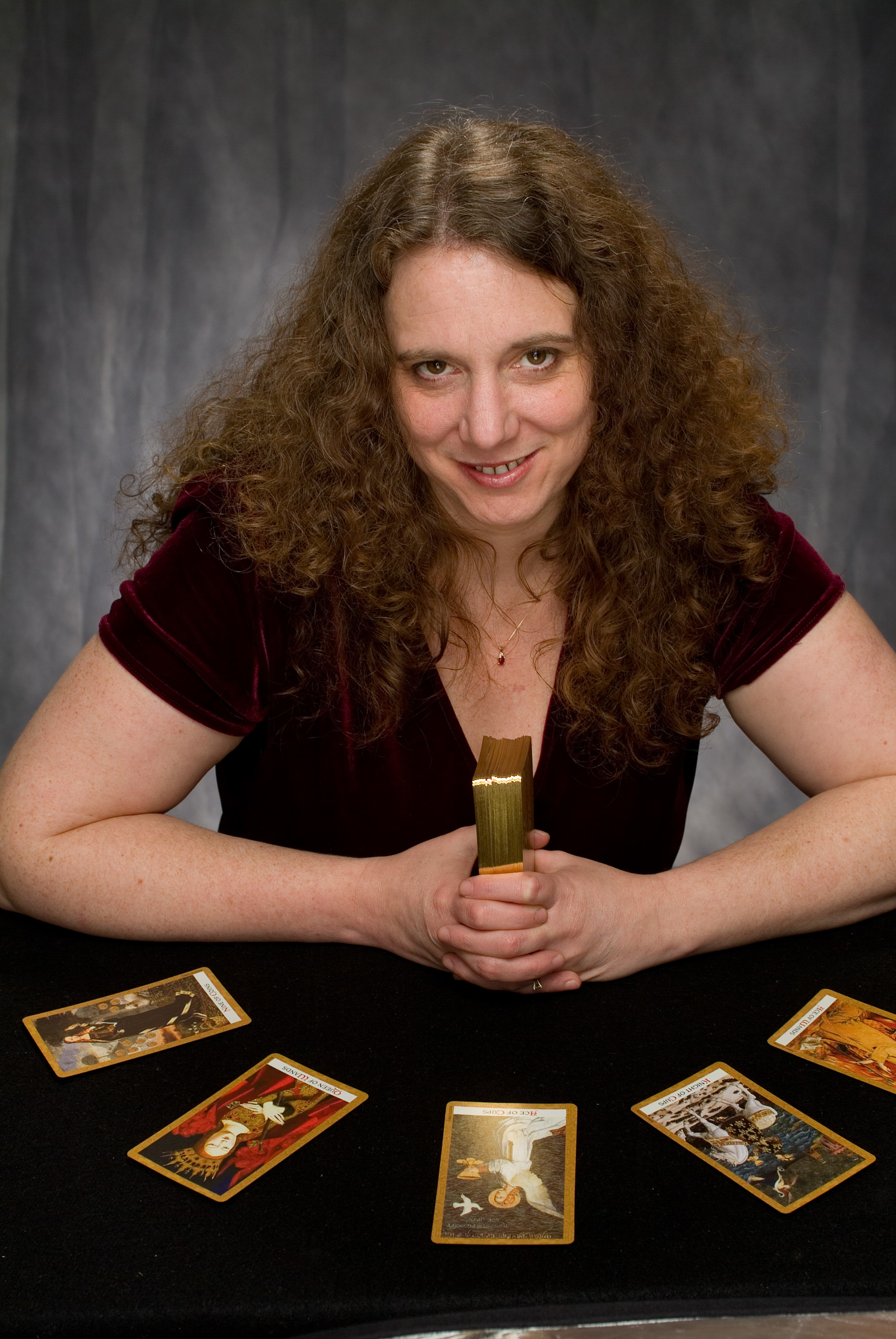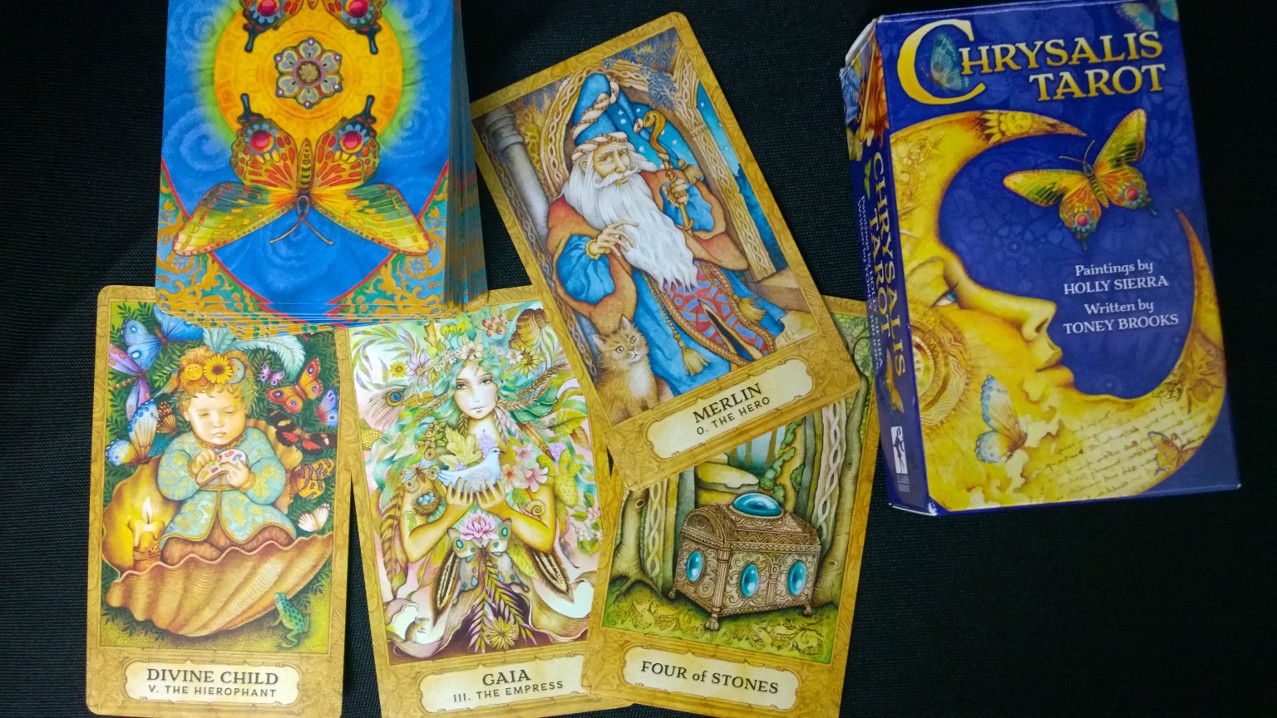
Welcome to my personal blog.
Here you will find my musings, thoughts and observations, all inspired by my experiences as a full-time professional tarot reader.
A Review of Chrysalis Tarot
Chrysalis Tarot , tarot deck reviewed December, 2014, on my personal blog. This review includes a video.
Chrysalis Tarot
by Holly Sierra and Toney Brooks
Published by U.S. Games Systems, Inc.
Of all the decks published in 2014, Chrysalis Tarot was the one I anticipated most hotly. I love Holly Sierra’s artwork. Indeed, each of the seventy-eight cards that make up Chrysalis Tarot is a delightful piece of collectible of art.
The deck is medieval and ancient feeling, with pastel colors and many scenes from nature. Each card has an antiqued tan marbled border. When you put the cards together side-by-side, the borders blend in to one another, making a connected picture.
The card images are rich in texture and imagery. The colors and characters are cheerful, but not sticky-sweet. Some of the scenes are fanciful, but not overly childish. Each image stimulates the imagination and the intuition.
Chrysalis Tarot is a standard-sized deck, packaged in the usual U.S. Games box with a 59-page Little White Book. The cards have a matte finish, and are on quality stock. The card backs are lovely, colorful and reversible, picturing two butterflies; one of the only obvious references to the “chrysalis” title of the deck.
The theme of Chrysalis Tarot is Otherworld Journeying.
The Major Arcana of Chrysalis Tarot belongs to the modern tradition of tarot I call “archetypal assignment.” In an archetypal assignment deck, the deck creator finds characters within a theme to fit the archetypes of tarot. In Kris Waldherr’s Goddess Tarot, for instance, each Major Arcana card is associated with a Goddess. In Lisa Hunt’s Ghosts and Spirits Tarot, each card is associated with a ghost story. Hunt and Waldherr each drew from cultures all over the world to find the right elements to fit the tarot archetypes. Other well-known archetypal assignment decks include Mythic Tarot, by Juliet Sharman-Burke, which uses characters from Ancient Greek mythology, and Ancestral Path Tarot, by Julie Cuccia-Watts, which uses four different world cultures to provide characters for the four suits.
The Court cards (in this deck, the Troupe) are my favorite illustrations. Each troupe character stands in a doorway of sorts. The doorway adds an extra border, which Sierra has decorated with flowers, flourishes and remarkable little scenes.
While the art of Chrysalis Tarot is simply outstanding, and the author, Toney Brooks, is clearly an excellent wordsmith, Chrysalis Tarot is non-traditional enough to present a few problems for some tarot traditionalists. I will be clear about my reaction to these problems in an effort to get Chrysalis Tarot into the hands of the people who will appreciate it, and to save the time and money of those who won’t.
The artist and author of Chrysalis Tarot, Holly Sierra and Toney Brooks, both claim some prior knowledge of tarot and metaphysics. They have intentionally created a deck where few of the old rules apply. Tarot traditionalists be warned, Chrysalis Tarot could make you angry. There could even be some argument over whether Chrysalis Tarot is indeed a tarot deck at all, or whether Diane Wilkes’ term “taroracle” (that is, an oracle loosely based on tarot) is more fitting.
I think there is a value to the study of non-traditional tarot decks. For example, Chrysalis Tarot re-imagines the Page of Pentacles as “The Acrobat.” For me to step out of my tried-and-true idea of who the Page of Pentacles is, and to try to imagine the Page of Pentacles as an acrobat, is a good tarot exercise. Either it will expand my understanding of the card to include these new ideas, or it will solidify my understanding of the card in a way that clearly defines what the card can and cannot symbolize for me.
Toney Brooks and Holly Sierra are working on a full-length companion book for Chrysalis Tarot. This is good news; if any deck ever needed or deserved a full-length book, it is this one. The ways in which Brooks and Sierra see the cards might make more sense if we had more background information.
Very often in the LWB, the stated key words and interpretations for individual cards are quite different from any classic or accepted meanings in any tarot tradition with which I am familiar. That’s fine, but little effort has been made to explain the inspiration behind the change, or the filter that was used to decide which traditions would be honored, and which would be changed. I am hoping the full-length book will clear up a lot of this for the many tarot traditionalists (like me) who truly want to love this deck.
As it is, I have a very hard time understanding how the Knight of Pentacles could be “spontaneous” and “confusing,” or why Major Arcana 14, Temperance, is called “Golden Flower.” The assignment for Major Arcana 12, the Hanged Man, is “Celtic Owl.” The owl, in Celtic lore, fits the theme of the deck as a keeper of the Otherworld. I’m not sure, archetypally, if this Celtic owl is an appropriate stand-in for the Hanged Man. Does this owl carry the same energy as Christ on the cross, or Odin on the tree, or yoga, or any of the other traditional associations for this card? I hope the book will answer the many thematic questions this deck presents.
It feels like an oxymoron that the artwork of Chrysalis Tarot is intricate and specific, and the thematic elements of the deck seem haphazard. While many of the characters in the Major Arcana are deities, some of characters are plants and animals that may be specific cultural symbols, but are not explained as such in the LWB. For instance, I had to Google on search terms “Golden Flower”, “Celtic Owl”, and “Divine Child” to make any sense of the Major Arcana at all. I learned that “Golden Flower” is an obscure cultural reference from the I Ching, but I am still not sure why it is the assignment chosen for Card 14, Temperance.
“Divine Child” for Major Arcana 5, the Hierophant, is another problem for me.. “Divine Child” is certainly an archetype; it’s just not the same archetype as the Hierophant.
Likewise, Merlin and his cat for the Fool (in this deck, the Hero) makes me want to give up and go home. First, yes, technically, the Fool is a “hero” in that he is the protagonist of an epic journey. However, the Chariot is usually associated with the archetype of “Hero”. Generally, the Fool is an explorer. Any heroic actions on his part would be by virtue of being in the right place at the right time, rather than intent. Merlin’s age, and his role in legend, also makes him a poor choice for the Fool, in my opinion.
In the LWB, the first line to describe the card reads, “Merlin’s cuddly cat draws you at once into his mystery and magic.” Sierra and Brooks had all of world mythology, history and literature from which to draw an Everyman character and the best they could find was “Merlin’s cat.”
My favorite assignments are Kali as the Tower, Phoenix for Judgment and Ma’at for Justice (Card 8). My favorite Major Arcana images are Gaia, the Empress and Golden Flower, Temperance.
The Minor Arcana suits of Chrysalis Tarot have standard elemental associations. The suits are gently color-coded, which will be a boon for newer tarot students.
The Water suit, traditionally Cups, is Mirrors. I like the idea of reflective mirrors for Water, although some of the images, though beautiful, are not terribly evocative of their traditional meanings.
For instance, the Ten of Mirrors is a colorful bird with ribbons. Attached to the ribbons are ten mirrors. The key word given in the book for this card is “Peace.” You have to stretch to make a connection with the traditional “love, family, friendship, home” meaning of the Ten of Cups. Those things are “peaceful,” but they are not “peace.” Traditionally, “Peace” is the key word of the Crowley Two of Swords, by contrast. It is many things like this that make Chrysalis Tarot feel a bit intellectually sloppy to me, an unhappy contrast to its precise and detailed artwork.
The Earth suit, traditionally Pentacles, is Stones. The pip Stone cards are quite appealing to me, especially the Four of Stones, an ornate bejeweled treasure chest, too large to fit through a door, and blocking the path.
The Fire suit, traditionally Wands, is Spirals. The Air suit, traditionally Swords, is Scrolls. I love the art in the Wands suit; Holly Sierra’s style is curvy and curly, with flourishes and details. The spirals feel textured and tactile. What I don’t like about Spirals and Scrolls for Wands and Swords is how very feminine the icons are. Traditionally, the masculine suits have phallic icons for a reason. Their absence weakens the energy of the deck for me.
Not all of the pip cards bear pictures of people. Some are animals, or forest scenes. Each of the pips is evocative enough to tell a story. Sometimes the obvious story easily matches the standard and familiar interpretation of the card, sometimes not.
The Court of Chrysalis Tarot is called the “Troupe”. Each of the sixteen characters has a unique name, like “The Acrobat” for the Page of Pentacles, or “The Sojourner” for the King of Cups. Again, I would love to know more about the process Sierra and Brooks used to find these particular names. My favorite images in the deck are the “Troupe” cards, but until I know the reasons behind their transformation, it is hard for me to embrace them. Many of their names don’t feel like a natural fit for me. For instance, why would a King “sojourn”? I would think, archetypally, “sojourning” would be the realm of Knights.
Chrysalis Tarot will be a wonderful deck for intuitive readers who don’t work with set interpretations, and for anyone who loves beautifully illustrated card oracles.
A new reader could easily work with the LWB and find Chrysalis Tarot a wonderful tool for divination, magick and personal growth. However, they would not be able to make an easy leap to any standard tarot deck without having to learn the traditional tarot associations.
Serious tarot readers may love the artwork enough to ignore the smarmy teardrop on the Sun (and many other annoyances) and find ways to work with Chrysalis Tarot. I’ve already done a few successful readings with this alluring deck.
Chrysalis Tarot is the perfect tarot deck for someone who doesn’t completely resonate with tarot, but wants a structured card oracle.
This deck proves it possible to love tarot and not care at all about the archetypes, just as it is possible to love tarot and not delve into the Kabbalistic or astrological associations. If you aren’t attached to the tarot archetypes, and don’t use them in your readings, you will very likely love Chrysalis Tarot.
Tarotists who work with archetypes may wish that Sierra and Brooks would use their astounding talents to create a tarot deck that more fully respects time-honored tarot traditions, or that more clearly and understandably defines a new tradition.
Chrysalis Tarot has enough substance to make you think. Some folks will enjoy the pretty pictures, some will get angry about the blatant disregard for tradition, and some will enjoy the opportunity to stretch a little.
Watch the video to see the deck images.
Christiana Gaudet Reviews Chrysalis Tarot
Video of Christiana Gaudet Reviews Chrysalis Tarot

